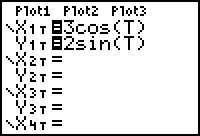The functions investigated in pervious modules have been real-valued functions, where the range of the function is a subset of the real numbers. In this lesson vector-valued functions, or simply vector functions, will be explored.
Vector Functions
A vector function is a function whose domain values are real numbers and whose range consists of vectors. Vector functions are often used to describe the motion of an object through space.
When a particle moves in a plane during a time interval, each of its coordinates is a function of time. So, the parametric equations below can represent the position of a particle at time t.
y = g(t)
A Position Vector
The graph of the parametric equations represents the path of the particle. The variable vector
r(t) = f(t)i + g(t)j
has its initial point at the origin and points to the particle's position at time t. Such a vector is called the position vector for the particle at time t. A position vector for time t is illustrated below.

The coordinates of the vector are determined by the function values given in the parametric equations at time t.
Velocity and Acceleration Vectors
The vector function for the position of a particle can be used to find the particle's velocity and acceleration.
The velocity vector for the particle, v(t), is the derivative of the position vector with respect to time.
The i component represents the velocity of the particle in the horizontal direction and the j component represents the velocity of the particle in the vertical direction.
The acceleration vector is the second derivative of the position vector with respect to time.
The i component represents the acceleration of the particle in the horizontal direction and the j component represents the acceleration of the particle in the vertical direction.
Illustrating the Path of a Particle
The graph of the path of a particle with a given position function can be illustrated on the TI-83. Display a graph of the path of a particle for the time (in seconds) interval [0, 2
![]() ] if its position is given by
] if its position is given by
- Select Parametric mode.
- Set X1T = 3 cos(T).
- Set Y1T = 2 sin(T).

-
Use the viewing window [0, 2
 , 0.1] x [ -4, 4, 1] x [-3, 3, 1].
, 0.1] x [ -4, 4, 1] x [-3, 3, 1].
- Make sure you are in Radian mode.
26.2.1 Graph the path of the particle. Click here for the answer.
26.2.2 Find the position vector for the particle at
![]() by using the Value command in the CALC menu and entering the value
by using the Value command in the CALC menu and entering the value
![]() for T. Then interpret the result. Click here for the answer.
for T. Then interpret the result. Click here for the answer.
Illustrating the Velocity of the Particle
Use the Numeric Derivative command found in the Math menu to create parametric equations that will return the velocity vector as a function of time.
- Set X2T = nDeriv(X1T,T,T).
- Set Y2T = nDeriv(Y1T,T,T).
- Unselect the position equations in the Y= editor.
- Graph the velocity curve in the same viewing window used for the position curve.
26.2.3 What do you notice about the graph of the velocity function? Click here for the answer.
26.2.4 Evaluate the velocity function at t =
![]() /4 by using the Value command in the CALC menu and entering T=
/4 by using the Value command in the CALC menu and entering T=
![]() / 4. Interpret the result. Click here for the answer.
/ 4. Interpret the result. Click here for the answer.
Illustrating the Acceleration of the Particle
In a similar fashion, the TI-83 can return the acceleration function, which is the derivative of the velocity function.
- Define X3T = nDeriv(X2T,T,T).
- Define Y3T = nDeriv(Y2T,T,T).
- Unselect the first two pairs of parametric equations.
- Graph the third pair of parametric equations in the same viewing window used previously.
26.2.5 What do you notice about the graph of the acceleration function? Click here for the answer.
26.2.6 Evaluate the acceleration vector at t =
![]() /4 and interpret the result. Click here for the answer.
/4 and interpret the result. Click here for the answer.
Do not clear the functions X2T, Y2T and X3T, Y3T because they will be used in Lesson 26.3.